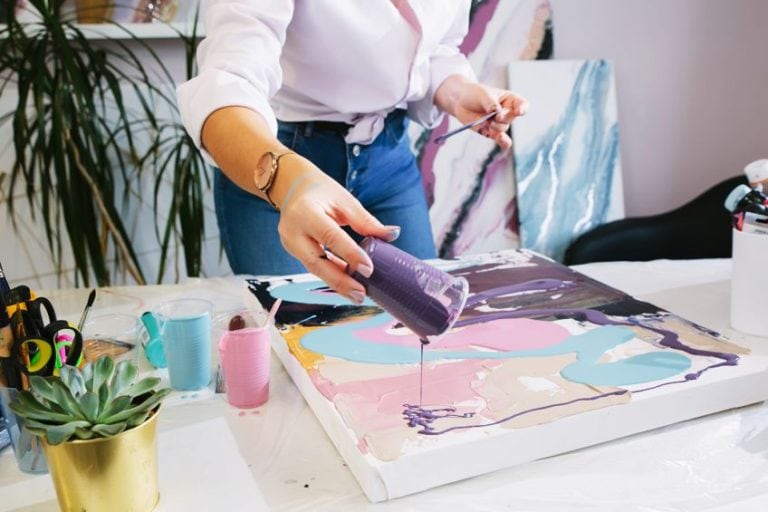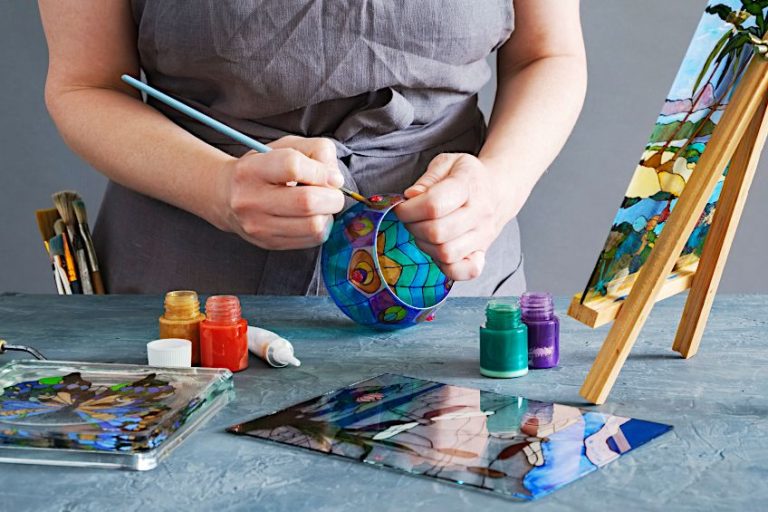Acrylic Paint on Leather – Best Paints for Decorating Animal Hide
Acrylic paints are loved by experts and beginners alike because of their versatility and affordability. As a testament to this, you can often see people using acrylic paints on clay, wood, denim, and plastic; not allowing their creativity to be bound only to a canvas. What if you wanted to use acrylic paint on leather? Can you use acrylic paint on shoes? Well, the short answer is that you absolutely can!
Is Acrylic Paint Suitable for Leather?
Acrylic paint can be used to paint on leather effectively but it is important to know what leather you are working with. The leather you use determines what kind of paint to use for the best result. Treated and/or dyed leather works well with high-flow acrylic paints because it allows retention of flexibility. For undyed, unconditioned, and untreated leather it is best to use a heavy-bodied acrylic paint or a fluid acrylic with a one-to-one ratio of an acrylic binder of choice, for example, this medium from Golden Artist Colors (GAC). To enhance vibrancy while using fluid acrylics, it may help to start with a base of white paint and layer color on top after allowing for the base layer to dry.
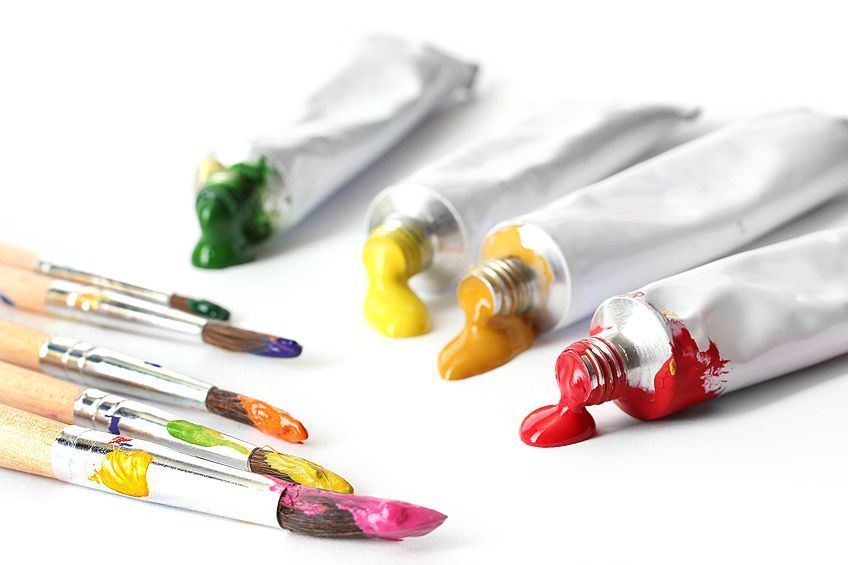
While it is possible to use acrylic paint on leather, you will need to prepare the surface before starting. Leather is a porous material and when painting it is ideal that the paint is absorbed. Absorption allows your project to turn out correctly and stand the test of time. Proper absorption will also prevent cracking while ensuring the paint doesn’t look as if it could be peeled or chipped off. The latter quality contributes towards a finished piece that looks more coherent and intentional.
Preparing the surface properly is what allows for acrylic paints to be absorbed in this way. Keep in mind that while leather-specific paints are an alternative option, you would still need to properly prepare your leather in this same way if you were using a more expensive paint designed specifically for use on leather.
In fact, most leather paints are actually just more specialized acrylic paints, however, there are some differences to keep in mind with this slight distinction.
What Is the Difference Between Leather Paint and Acrylic Paint?
Acrylic leather paint is a specialized form of acrylic paint that adheres to prepared leather more readily. While acrylic leather paint is more reliable in terms of longevity and adhesion, it is more expensive and difficult to work with if you are used to smoother paints. Also, take note that we said acrylic leather paint works with better adhesion and recall what we previously mentioned regarding absorption.
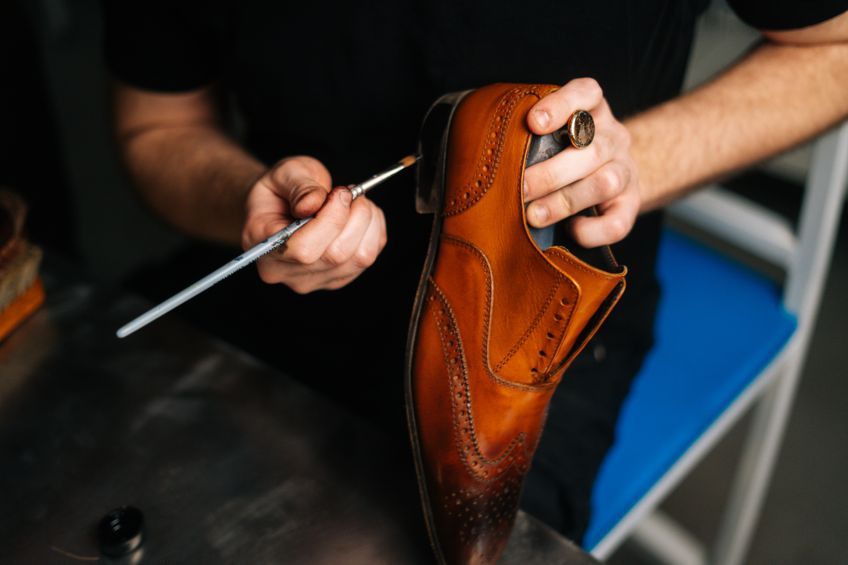
Therein lies the crux of the decision; acrylic leather paint has a greater chance of holding on with ease but it sits on the surface of the leather more thickly. Meanwhile, normal acrylic paint may take some trial and error at the beginning but ultimately absorbs into the leather cohesively once applied correctly. Normal acrylic paint is also more affordable and versatile. This means that you will not be left with tubs of leather-specific paint after finishing only a handful of projects.
How to Prevent Acrylic Paint from Cracking
The main issue you may face while using acrylic paint on leather is cracking on the paint as it dries or while you use the item. Some techniques and products can help you avoid cracking on your piece. Here are some general tips to prevent cracking on non-leather specific acrylic paint on leather:
- Try not to mix different brands of paint as the difference consistency can cause blending issues and result in cracking.
- Apply the paint in thin, even layers. Thick, uneven layers encourage cracking and can look unpleasant.
- Paint along the same direction as creases in the leather. This could mean the creases of a jacket or the flex of a shoe.

- Make sure that each layer has properly dried. Now allow the leather to crease along its lines slightly before adding the next layer of paint. This prevents the acrylic paint from hardening within the creases of the leather. Hardened creases are stiff and inflexible which is a precursor to cracking.
- Don’t try to speed up drying by placing near a fan or using heat as this prevents proper absorption.
- Make use of a protective coating of your choice. Some options are Acrylic Paint Sealer, Fabric Medium, or Acrylic spray sealer.
Our Recommendation for Acrylic Paint on Leather
When choosing products to use it is important to think about how they will interact with leather. Many non-leather-specific products will work great on leather while maintaining versatility for other projects. The product listed below has its pros and cons that we have outlined.

Best Paint Pens: BETEM Acrylic Markers Paint Pens
This set of fine-tipped paint pens has 24 different colors at a great price. The colors are vibrant and the pens allow ease of use for people of all skill levels. Being highly affordable and having many possible applications aside from leather, it is a really good choice for general hobbyists.
- 24 vibrant colors
- Dual-tip design
- Multi-surface application
PROS
- Versatile
- Vibrant Colors
- Multi-Surface Application
CONS
- Limited Color Selection
- Durability Concerns
A Step-by-Step Guide to Painting Acrylic on Leather Shoes
This all begs the question: can you use acrylic paint on shoes? Of course! Whether it’s a pair of Doc Martens or an old pair of loafers, you can spruce them up or customize them by adding some acrylic paint designs. Below we have outlined how to paint shoes with acrylic paint.
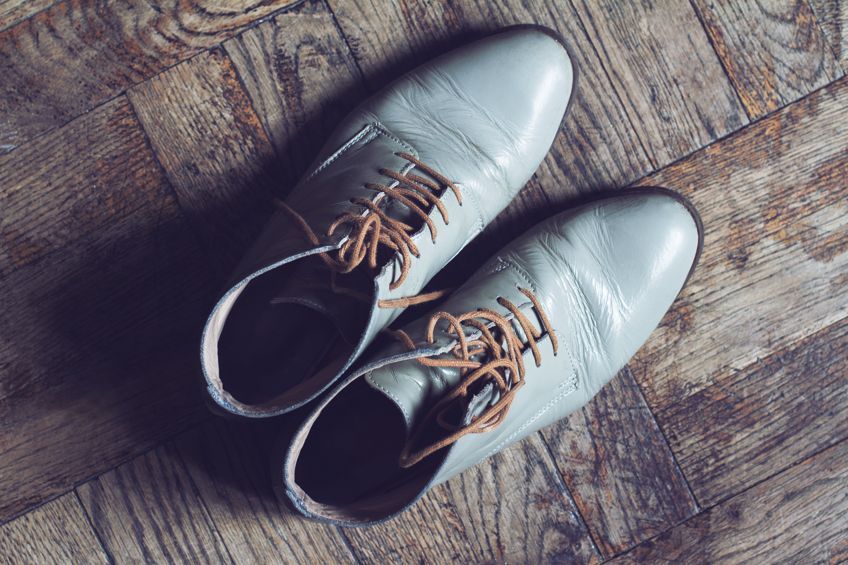
Before you begin, you will need to gather some tools and supplies. We have created a list below to help you get everything you need ready to begin painting leather. Here are our suggestions:
- Your leather shoes
- Old newspapers or a tarp
- Isopropyl alcohol
- A wool daube
- Cotton buds
- Paper towels
- Acrylic paint
- At least one paintbrush
- A leather deglazer
- Fine sandpaper
- Tape
- A sealant of your choice
- A fabric medium
Plan Your Design
The first step is to properly plan what you want to paint on the shoes and where everything is going to go. You may be excited and just want to jump straight in, but it is best to have an idea of how you want it to look in your mind before you begin. Take a look at the shoe and maybe even consider sketching some drafts before putting paint to the leather.
Find inspiration on the internet of some designs or patterns for acrylic paint on shoes.
Prepare Your Workspace
Place a tarp or old newspaper pages down wherever you will be working. You don’t want to get acrylic on a carpet or a piece of furniture while you work, and it is best to not have to worry about accidentally making a mess. Try to choose somewhere that is well-lit and ventilated but with no direct sunlight or gusts of wind present. Too much heat or air movement can prevent the acrylic from properly bonding to the leather.

Prepare Your Materials
Next, you will gather all your materials together. Keep a cup of water near you so that you can keep your brushes clean once you begin working. Make sure that you know what colors you want to use and if you need to mix any colors, now is the time to do it. Now is also the time to add your fabric medium to your acrylic paint, if you have decided to use one. Fabric Mediums will help the paint adhere better to your shoes and prevent possible cracking.
Be sure to follow the manufacturer’s instructions while using your fabric medium of choice.
Clean and Prepare the Shoes’ Surface
Wipe the surface of the shoes down with a damp paper towel if there are any large bits of dirt or grease. Dry the shoe thoroughly and then repeat the process with the cotton dauber and isopropyl alcohol. This should remove some of the gloss from the leather shoe. If this has not happened, repeat this process until the shoe is no longer glossy.

If you have a leather deglazing agent (optional) you can use it to remove the gloss from the shoe after the first wipe down with isopropyl alcohol. Follow the instructions given by the manufacturers of your deglazing agent to do this. If you are using leather paint for shoes you may not need to prepare the surface of the leather to this degree, but it would still improve the adhesion and longevity of the paint. If you have sandpaper (optional) you can lightly sand the surface of the shoe to remove the gloss, just make sure to properly dust off the shoe before you begin painting.
If you aren’t painting the entire surface of the shoe, try to only sand where you will be painting, and make sure to coat any deglazed parts of the shoe with sealants once you have finished painting.
Begin Painting the Shoes
Now it is almost time to start painting. If you have tape ready (optional) then you can tape off areas of the shoe before you begin painting. Tape can help you avoid specific areas with ease or allow you to create clean straight lines in your design. When you start painting (or drawing) make sure that you are doing thin layers and allowing each layer to dry properly, before going over it a second or third time. Remember to paint in the same direction as creases in the shoe. Once each layer has dried, flex the shoe along its crease before painting the next layer. This can help to prevent paint buildup in the creases which can lead to cracking.

If you make mistakes use a paper towel or cotton bud to dab away the paint. Repeat this after dipping the towel or bud in warm soapy water. Continue until the area is clear. Make sure you have properly dried the surface again before continuing.
Enjoy Your Completed Piece
You should now have acrylic painted leather shoes to wear around town or to gift to a friend. What is so great about painting on leather, is that you can easily have a unique piece of clothing or furniture that you are proud to say that you made on your own. Even if someone made the same design as you, there would be small changes in technique or it could be on a different leather item.
In other words, you know what you have made is truly one of a kind. Acrylic paint on shoes is a great way to make an effortless statement.
How to Seal Acrylic Paint on Leather
Once your shoes are painted to your liking allow them to dry and then check for any imperfections. Touch up anything that isn’t quite right and allow it to dry, then start to seal your acrylic onto the shoe. Whether you are using a liquid sealant with a brush or a spray sealant, the goal is to achieve thin, even layers on your piece. Much like with the paint you will be allowing each layer to dry properly before continuing.

If you used acrylic leather paint for shoes you may not need to seal your finished piece but it would still ensure the maximum longevity of the paint. While leather paint for shoes would not need to be sealed as much as regular acrylic paints, it would still benefit from an additional layer of protection. To ensure the maximum longevity of your piece it is best to seal the paint properly during and/or after application. There are many ways to seal acrylic paint on leather. Below we have outlined how to seal acrylic paint on leather and explained the benefits and downsides of each option.
Liquid Paint Finisher
This Acrylic paint sealer is popular with many crafters using acrylic paint on leather and comes highly recommended. It provides a matte finish that prevents cracking and damage over time or through usage. A liquid paint finisher can be applied with a rag, sponge, dauber, brush, or spray gun. This makes it both affordable and easy to use. We highly suggest using a liquid paint finisher to seal your acrylic paint on leather.
However, if you don’t want a whole bottle of acrylic paint sealer just for one small project, we have a few other suggestions.
Sealant Spray
Acrylic spray sealer works just as well as liquid paint finisher but can be a bit trickier to use if you are not familiar with using spray cans. It is ideal to get thin, even layers on your piece by spraying in short, light bursts and waiting for each layer to dry before repeating. Try practicing on a scrap piece of paper or cardboard before attempting to seal your acrylic paint on leather. Acrylic spray sealer is a great and affordable option once you get used to using a spray can properly.

Fabric Mediums
Another option that can be used on other textile projects that aren’t leather-based is fabric mediums. A fabric medium can help with sealing acrylic onto leather but it will not be applied as a topcoat, rather it will be mixed into the paint before application. Fabric mediums thus help acrylic paint hold more readily upon application rather than adding extra protection after the matter. This can be convenient if you don’t want to seal your work with an extra coating, but may not hold as long as an extra protective layer would.
Ideally, you would want to use a fabric medium and a finisher or clear coating spray in tandem to ensure maximum longevity, but it is not absolutely necessary.
We have already mentioned the GAC 900 fabric medium, but we also suggest the Angelus 2-Soft Fabric Medium. All these options come highly recommended by crafters. Manufacturers suggest using the same brand for a paint, medium, and sealant but this does not seem necessary and does not significantly affect the outcome of the project. Keep in mind that the GAC 900 and the 2-Soft Fabric Mediums both require heat settings to work properly. If using either of these brands be sure to follow the instructions and safety precautions listed by the manufacturer.
Some Other Options to Consider
Some other options for sealing include mod podge, waterproofing spray, and hairspray, but we do not recommend these methods as highly as those above. However, while these methods are not as reliable they can still offer benefits in specific situations. If you only need a temporary seal on your work or are making a decorative object rather than a wearable piece, then these options may be viable for you.
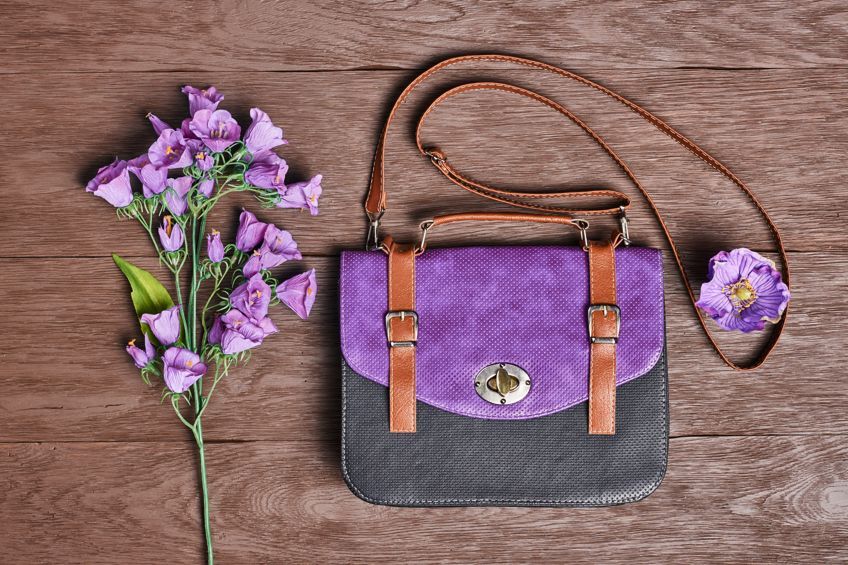
Mod podge is a quick and easy way for crafters to seal their acrylic paint on leather but is more temperamental and has mixed results. That being said it is important to only apply the mod podge in thin layers for the best result. It may be tempting to seal with mod podge if you already have some sitting around but keep in mind that it will be tricky to apply and will only be durable temporarily. If this sounds okay to you, then pull out your mod podge and get started.
Hairspray is another option that we suggest only be used in one instance: if you are making a piece that is a flat, rigid surface.
In other words, if you are painting on a wallet, shoes, belt, or jacket this is not the method that you should consider for sealing your acrylic paint on leather. It may also be tricky to find the right brand of hairspray that would work properly as a sealant. So while this may seem like an affordable option it may not be very practical for some people. The crafting community is divided on their opinion about hairspray as a sealant for acrylic, so perhaps you may want to look into specific brands of hairspray that are known to produce the best results. Remember that even the best hairspray in this regard will not properly seal acrylic on non-rigid leather items.

Waterproofing spray is cheap, convenient, and extremely durable but it may coat too thickly and unevenly on your piece if you do not apply it correctly. As with other sealants, it is best to get thin, even layers on your piece. It may be useful to get comfortable with the can and the spraying movements by practicing on cardboard before trying to coat your piece. If used successfully, waterproofing spray will be an extremely durable top layer for any of your acrylic on leather projects.
How to Remove Paint from Leather
At this point, you may be wondering how to remove acrylic paint from leather. If the acrylic paint is already dry it is difficult to remove it completely without the possibility of damaging the leather. This means that if you plan on painting your leather accessories, you must make sure that you are prepared to have them remain painted indefinitely. However, if you do change your mind at a later point and don’t mind the risk of damaging the leather to some degree in the process, we have laid out some methods below.
To remove dry acrylic paint off of leather you can gently lift and scratch the paint off with a knife. Be careful not to damage the surface of the leather.
You can then wipe the area down with a warm soapy water solution. Let it soak for a while then scrub lightly with a scrubbing pad. Repeat this process until the surface has been cleared of paint. Mild citrus detergents have proven to work very well in this regard. Follow this process with a leather cleaner and conditioner if there is still some discoloration or smudging on the surface of the leather. This will help bring back the natural sheen of the leather.
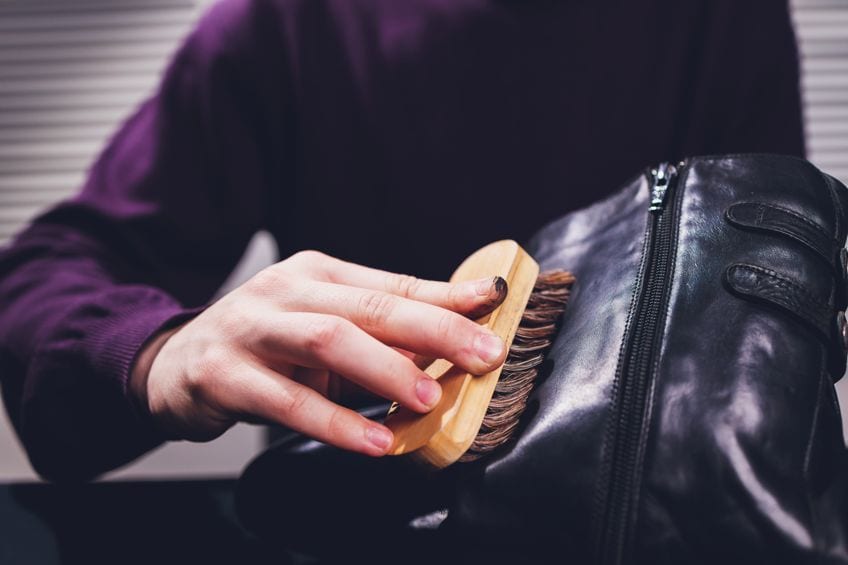
Removing paint from leather while it is still wet is a lot easier than when it has dried. Use a dry paper towel or cotton swab to dab and wipe as much of the paint off the surface as possible. Be careful to ensure you are not spreading the paint or dabbing it onto other places of the leather. Next, use some mild detergent mixed with warm water on a paper towel or cotton swab to clean the remaining residue off of the surface of the leather.
This same technique can be used to fix any mistakes while applying acrylic paint, just be sure to use a cotton bud if you are fixing small mistakes. Before continuing to paint, make sure that you have properly dried the area, or else the acrylic paint will not properly attach to the leather. Any remaining water could also dilute the paint and create texture and color inconsistencies on your piece.
Other Craft Ideas for Acrylic Paint on Leather
The possibilities for painting on leather with acrylic are endless. From simple patterns to angel wings and cartoon characters. Using acrylic paint on leather is a great way to spruce up more than a pair of shoes.
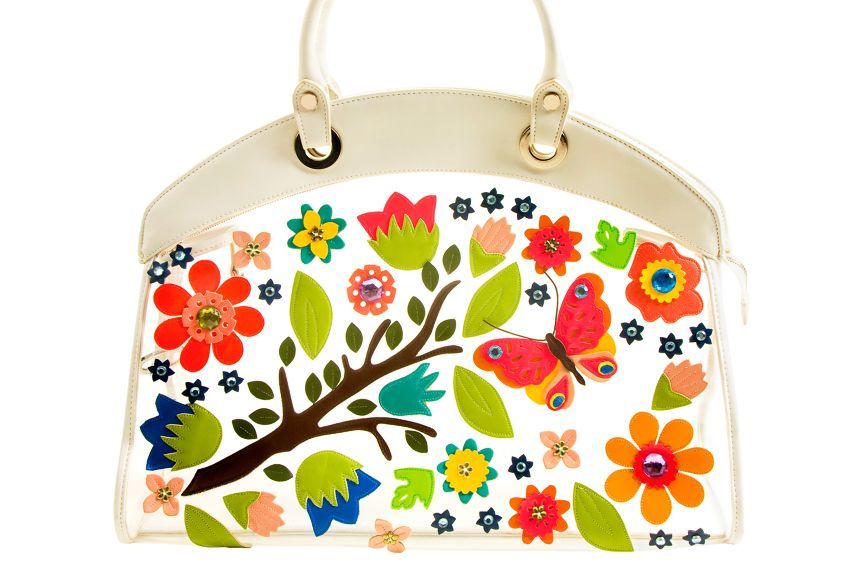
Now that you know how to paint shoes with acrylic paint you can try to breathe life into other accessories, objects, or articles of clothing such as:
- A belt, jacket, purse, handbag, or wallet
- Leather furniture or car seats
- Murals on leather to be hung on a wall as art
- A leather-bound book or photo album as a gift for a loved one
Acrylic paint is an extremely versatile medium while leather is a durable and unique base. Overall, using this combination in your crafting will be a greatly rewarding and interesting way to improve your skills. The knowledge you gain and the techniques you learn will improve your ability as a crafter.
Frequently Asked Questions
How Long Does Acrylic Paint Take to Dry on Leather?
Depending on the paint used it can take a few minutes to two hours for each layer to properly dry. Once a layer has properly air dried you can add the next layer of paint. When your whole piece is completed, allow it to dry for a minimum of 4 to 6 hours before sealing. Remember that there are a lot of factors that affect how quickly your paint will dry, such as humidity and air temperature. The estimates given here may not be accurate depending on where you live and the season you are in.
Can Leather Be Spray Painted?
Yes, it is possible to spray paint on leather. Just be sure to use paint that is suitable for leather and spray-painting. Spray painting on leather can be tricky as you may get blotches. If you have experience with spray paint then the thin, even layers are exactly what you would want on leather.
Do You Dye Leather Before Painting?
Yes, you can paint on dyed leather but you don’t have to. If you have dyed your leather, make sure that the dye has properly dried before you begin painting. An undried dye can cause problems if you try to paint atop it. Once the dye is dry you would follow the same technique for painting as explained above. Depending on the finish of your dye you may need to pay extra attention to how you prep your leather before you begin painting.
Is It Better to Paint or Dye Leather?
Both dying and painting have applications that they are best suited for. Leather dyes penetrate the fibers of the leather and accentuate the natural patterns of the leather. Although this can enhance the appearance of stains. Dyes cannot be used to cover dark stains or to lighten the color. Only pigmented finishes such as paints can accomplish this. Acrylics tend to look more vibrant than dyes. Pleather or vinyl cannot be dyed, but it can be painted or refinished. Dyes also require a protective finish to prevent staining and sun damage more than paints do.
In 2005, Charlene completed her Wellness Diplomas in Therapeutic Aromatherapy and Reflexology from the International School of Reflexology and Meridian Therapy. She worked for a company offering corporate wellness programs for a couple of years, before opening up her own therapy practice. It was in 2015 that a friend, who was a digital marketer, asked her to join her company as a content creator, and this is where she found her excitement for writing.
Since joining the content writing world, she has gained a lot of experience over the years writing on a diverse selection of topics, from beauty, health, wellness, travel, and more. Due to various circumstances, she had to close her therapy practice and is now a full-time freelance writer. Being a creative person, she could not pass up the opportunity to contribute to the Art in Context team, where is was in her element, writing about a variety of art and craft topics. Contributing articles for over three years now, her knowledge in this area has grown, and she has gotten to explore her creativity and improve her research and writing skills.
Charlene Lewis has been working for artincontext.org since the relaunch in 2020. She is an experienced writer and mainly focuses on the topics of color theory, painting and drawing.
Learn more about Charlene Lewis and the Art in Context Team.
Cite this Article
Charlene, Lewis, “Acrylic Paint on Leather – Best Paints for Decorating Animal Hide.” Art in Context. November 25, 2021. URL: https://artincontext.org/acrylic-paint-on-leather/
Lewis, C. (2021, 25 November). Acrylic Paint on Leather – Best Paints for Decorating Animal Hide. Art in Context. https://artincontext.org/acrylic-paint-on-leather/
Lewis, Charlene. “Acrylic Paint on Leather – Best Paints for Decorating Animal Hide.” Art in Context, November 25, 2021. https://artincontext.org/acrylic-paint-on-leather/.








